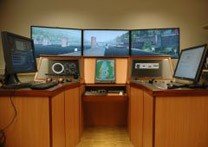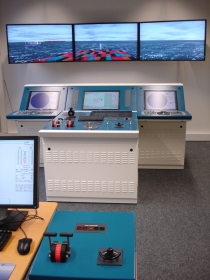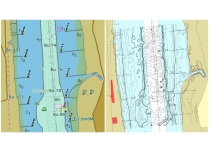Ship Handling Simulation
From BAWiki



The Hydraulic Engineering in Coastal Areas department of the BAW advises the WSD North and WSD Northwest among others in the context of fairway design with regard to adapting the shipping channels to large vessels (e.g. Lower and Outer Elbe river, Lower Weser river, Outer Weser river, also the approaches to Stralsund and the Peenestrom). Today the results of ship handling simulations are of considerable relevance to the decision-making processes involved in the definitive stipulation of fairway dimensions. Ship handling simulators are deemed to be valuable in rating fairways and are recommended for critical marginal conditions (e.g. minimizing fairway dimensions (see also PIANC WG II-20, 1992; PIANC WG II-30, 1997), although the limits for this kind of application are still uncertain. The BAW is consulted primarily by the WSV for professional advice when it comes to tender procedures for simulation assignments and for verifying the rating methods. Assessments of the ship handling simulation software currently devised for nautical issues led to the conclusion that the mathematical methods of the simulation systems (e.g. regarding the squat and bank effect) relevant to fairway rating do not satisfy the professional demands made by the WSV. Given the fast increase in the size of ships used for container shipping and the long planning phases necessary for measures to adapt the shipping channels, a professionally confirmed navigability analysis for future large container ships is necessary for example for the estuaries of the rivers Weser and Elbe and also for the Kiel Canal.
The urgency of the task becomes even clearer when attention focuses on the need to make commercial use of the waterway infrastructure in its present or future adapted form, so that there is a need for continuous on-going development of the modular simulation software, also in the form of development and implementation work.
Working on the basis of a commercial simulator intended for the training of nautical personnel on seagoing ships, the existing calculation kernel is being expanded with the addition of methods for calculating ship-induced waves and for predicting the movement of inland vessels in extremely shallow water while taking account of current fields. Following the development work, movement dynamic tests will be carried out in exposed sections where e.g. current fields with a transverse impact on the ship affect its movement, or where the section can only be used for manoeuvres.
Two different methods are planned for the tests. To make the simulation results as objective as possible, the simulation runs are normally steered in a control circle to make sure that the model ship follows a stipulated line. This warrants that the actions and capabilities of the "master" remain constant throughout all the tests and also ensures that the results of the individual simulation runs will all be comparable. The navigability of the particular area with regard to the defined line in itself and the number and strength of ship's manoeuvres that have to be carried out during the simulation run provide an indication as to how certainty and easiness apply to the navigability of the test section.
If psychological aspects affecting the master in his decisions play a role during the tests, it is possible for the ship to be steered through the test section by a master in the line of sight. To this end, the master is provided with a reconstructed bridge equipped with practically original controls of an inland vessel. Three monitors show the outside view. A wide range of different controls can be installed to make the simulator as flexible as possible in terms of ship type, drive type and ruder equipment. The instruments needed by the master are shown in generic form on monitors in the control panel.
- Quality Assurance for Ship Handling Simulation at the WSV
- Tidal Current Data for Ship Handling Simulation at the WSV
back to Hydraulic Engineering Methods
